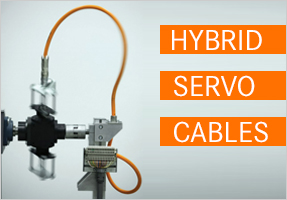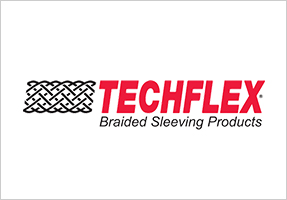
Hybrid Cables Handle Servo Power and Feedback
New Servo Cables Address Requirements of Hiperface DSL® Communications
Original Content Written By: Lucas Kehl, Product Manager at LAPP
Of all the components that make up an effective servo system, the power and signal cables don’t get much attention. Yet the cabling plays a big role in the system’s performance and lifecycle cost.
That role is about to get even bigger, thanks to an emerging digital communications interface for servo systems.
Called Hiperface DSL® by SICK, this new communications interface allows power and signal to share a single cable.This hybrid cable can drastically reduce the installation and maintenance costs associated with servo systems.
At the same time, the hybrid cable supports servo performance advantages related to Hiperface DSL’s robust handling of feedback signals, which includes transmission rates up to 9.375 MBaud at lengths up to 100 meters.
If you’ve spent any time designing servo systems, the entire notion of a hybrid cable may cause some concern.
Common engineering practice requires separate cables for motor power and feedback
signals to avoid problems with electrical noise and crosstalk.
The Hiperface DSL standard avoids these concerns—as long as you use the right kind cable.
Hybrid cables designed for the Hiperface DSL interface need to be carefully constructed to ward off electromagnetic noise and crosstalk between the power and signal conductors. The cables, which serve in demanding automation systems, also need to be durable.
Here’s a closer look at the technical features of a good hybrid cable:
Ideal Hybrid Cable Design
Think of the new hybrid cables as a fusion of servo and feedback cables. With this approach, both power and data are transmitted via one shared cable, and there’s no need for a separate encoder or resolver cable.
This shared cable can have many different configurations, but most commonly it consists of three
power cores, one green-yellow protective conductor and an optional control core pair for an electric
brake.
An additional signal pair handles all the motor feedback communications and can optionally transmit data from a motor-winding temperature sensor.
The key to this arrangement is that the position signals from an encoder or resolver are modulated to the power supply voltage of the feedback system.

Alternative hybrid cable designs are also possible to support other fieldbus communications architectures - such as industrial Ethernet, polymer optical fiber (POF) and polymer clad glass fiber (PCF).
Tight Electrical Specifications
Since data needs to be transmitted along hybrid cables in close proximity to the power, it’s of vital importance that the cable be designed and manufactured to meet very tight specifications for the key electrical parameters.
For example, the characteristic impedance for Hiperface DSL is specified at 110 Ω with a narrow ± 10 Ω tolerance. Other parameters that require a tight control within a defined frequency range include capacitance, inductance, resistance, impedance and attenuation characteristics.
Also, a well-designed hybrid cable will raise the bar on electromagnetic compatibility (EMC).
As more and more electro mechanical automation systems make their way onto the factory floor—a clear trend in the age of the Smart Factory—the potential for electromagnetic noise is increasing rapidly.
If not designed with proper shielding, hybrid cables can be particularly sensitive to electromagnetic interference because of the proximity of the power and signal conductors.
Hybrid Cable Technical Features for Stationary Version
- Minimum Bend Radius: 5 x cable diameter
- Temperature Range: -40°C to +80°C
- Nominal Voltage: (Power and Control)
- UL: 1000V
- IEC U0/U: 600/1000V
- Signal Pair: 300V (not for power)
- Test Voltage:
- Power and control: 4000V
- Signal Pair: 1000V
- Conductor Stranding:
- Class 5 fine wire
- Signal pair: 7 wires
- Control pair (optional): Class 5 fine wire
- Color Code:
- Power Conductors (U/L1/C/L+, V/L2, W/L3/D/L-): Black with white printing plus green/yellow ground
- Signal Pair: White and blue
- Control Pair (optional): Black with white numbers: 5, 6
- Approvals:
- UL: AWM 2570 (80°C, 1000V)
- Canada: cRU AWM I/II A/B FT1 (80°C, 1000V)
- Additional: Based on VDE specifications CE & RoHS
Mechanical Robustness
While some hybrid cables will power stationary systems, most servo systems move. So look for hybrid cables that offer continuous flex performance and compatibility with cable tracks.
These cables tend to use extra-fine Class 6 conductor wire, since it tolerates flexure better than the slightly coarser Class 5 wire used in static applications. For cable track compatibility, you’ll want cable constructions that minimize lay lengths and bend radii.
A continuous flex hybrid cable will need more rigorous lifecycle testing. It’s essential to perform this testing under realistic conditions and with adequate bending cycles.
At LAPP, for example, we subject continuous flex hybrid cables to as many as 10 million alternate bending cycles, capturing continuous dynamic data through each bend.
Single Cable Future
It’s easy to see why hybrid cables for servo drives are a hot topic right now.
This emerging approach to cabling can produce significant cost savings by eliminating the need for separate encoder cables, connectors and installation labor.

Diagram of Continuous Flex Servo Cable
With smaller drives in particular, the cost of a feedback cable and an M23 connector relative to the cost of the entire drive can be significant.
Hybrid cables also take up less space in a cable carrier—by eliminating not just an encoder cable but also the minimum distance that must be maintained between conventional servo and encoder cables with different voltage classes.
Despite these benefits, keep in mind that there’s still work to be done before single-cable solutions take over our factory floors. In particular, not all motor and drive makers currently support the Hiperface DSL standard.
And the ones that do are adding it to new servo products, so the single-cable approach targets new installations for now.
LAPP Tannehill Carries Hybrid Servo Cables
We offer the following LAPP ÖLFLEX® hybrid servo cables at Lapp Tannehill:
Shop the links above or reach out to us via our website chat if you have questions or need more info on hybrid servo cables!













